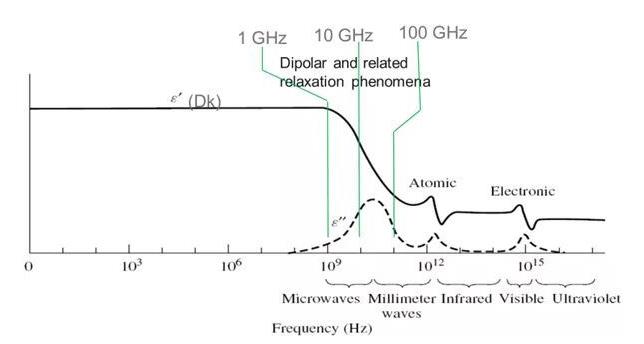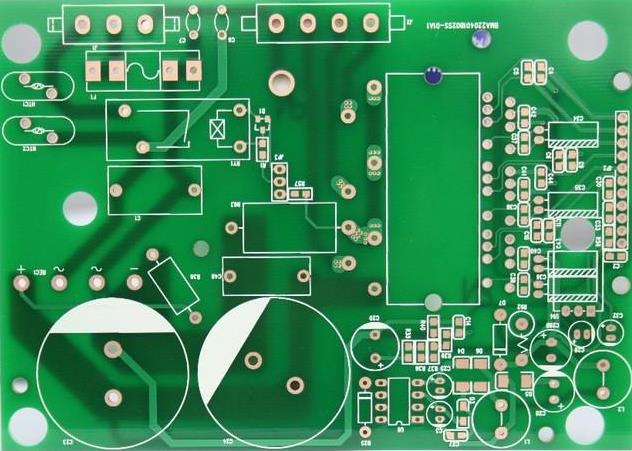With the increase of PCB circuit board DK, it is more and more difficult to control the phase consistency of printed circuit board (PCB) materials. Accurately predicting phase changes of circuit board materials is not a simple or routine task. The signal phase of high frequency and high-speed PCB depends largely on the structure of the transmission line processed by it and the dielectric constant (DK) of the circuit board material. The lower the Dk of the medium (for example, the Dk of air is about 1.0), the faster the electromagnetic wave propagates. With the increase of Dk, the propagation of waves will slow down, and this phenomenon will also affect the phase response of the propagating signal. When the Dk of the propagation medium changes, waveform phase changes will occur, because a lower or higher Dk will make the speed of the signal in the propagation medium correspondingly faster or slower.
PCB circuit DK of material is usually anisotropic, with different Dk values in three dimensions (3D) of length, width, and thickness (corresponding to x, Y, and Z axes). For some special types of circuit design, it is necessary to consider not only the difference of Dk but also the impact of circuit manufacturing on phase. Phase stability and predictability will become increasingly important as PCB operating frequencies increase, especially at microwave and millimeter-wave frequencies, such as fifth-generation (5G) cellular wireless communication network infrastructure equipment, and advanced driver assistance systems (ADAS) in electronically assisted vehicles.

So what causes the Dk of circuit board material to change? In some cases, differences in The Dk on the PCB are caused by the material itself (e.g. changes in copper surface roughness). In other cases, PCB manufacturing processes can also cause DK changes. In addition, a harsh working environment (such as high working temperature) can also cause PCB circuit Dk to change. By understanding the characteristics of materials, manufacturing process, working environment, even Dk test method, and other aspects to study how PCB DK changes. In this way, the phase change of PCB can be better understood and predicted, and its impact can be minimized.
Anisotropy is an important property of circuit board materials, and the properties of Dk are very similar to "tensors" in three-dimensional mathematics. The different Dk values on the three axes lead to the difference in electric flux and electric field intensity in three-dimensional space. Depending on the type of transmission line used in the circuit, the phase of a circuit with a coupled structure can be changed by the anisotropy of the material, and the performance of the circuit depends on the direction of the phase on the circuit board material. In general, the anisotropy of circuit board materials will vary with the thickness and working frequency of the plate, and the materials with lower Dk values have smaller anisotropy. The filling reinforcement also contributes to this change: PCB materials with glass fiber reinforcement generally have greater anisotropy than PCB material without glass fiber reinforcement. When phase is the key indicator and the PCB's Dk is part of the circuit design modeling, describing and comparing the Dk values between two materials should be for the Dk on the same directional axis. For more detailed information on the various factors (including measurement methods) that change the PCB material Dk, See Rogers' webinar "UnderstandHow Circuit Materials and Fabrication Can Affect PCB circuit Dk Variation and PhaseConsistency (understanding how PCB materials and manufacturing processes affect PCB Dk variation and PhaseConsistency).
An in-depth look at the design Dk
The effective Dk of a circuit depends on how electromagnetic waves propagate in a particular type of transmission line. Depending on the transmission line, part of the electromagnetic wave will be transmitted through the dielectric material of the PCB, and the other part will be transmitted through the air around the PCB. The Dk value of air (about 1.00) is lower than that of any circuit material, so the effective Dk value is essentially a combined Dk value, which is determined by the combined action of the electromagnetic wave propagating in the transmission line conductor, the electromagnetic wave propagating in the dielectric material, and the electromagnetic wave propagating in the air around the base. The "Design Dk" is an attempt to provide a more practical Dk than the "Effective Dk" because it takes into account the combined influence of different transmission line technologies, manufacturing methods, wires, and even the test methods used to measure the Dk. Design Dk is the Dk extracted when testing materials in circuit form, and it is also the most suitable Dk value for use in circuit design and simulation. The design Dk is not the effective Dk of the circuit, but it is the material Dk determined by the measurement of the effective Dk, and the design Dk can reflect the true performance of the circuit.

The surface roughness of conductor copper foil in different thicknesses of PCB dielectric material has different effects on the phase response of design PCB circuit DK. Materials with thicker substrates are often less affected by the surface roughness of copper foil conductors. Even for copper foil conductors with a rough surface, the design Dk value is closer to the medium Dk of the substrate material. For example, Rogers' 6.6 mils RO4350B™ circuit board material has an average design Dk of 3.96 at 8 to 40GHz. For the same material with a thickness of 30 mils, the design Dk decreased to an average of 3.68 in the same frequency range. When the material substrate thickness is doubled again (60 mils), the design Dk is 3.66, which is the intrinsic Dk of the medium for this glass fiber reinforced laminate.
From the above examples, it can be seen that thicker substrate is less affected by copper foil roughness and the design Dk value is relatively lower. However, if thicker circuit board are used to produce processing circuits, especially at millimeter-wave frequencies with smaller signal wavelengths, it is more difficult to maintain the consistency of signal amplitude and phase. Higher frequency circuits are often more suitable for thinner circuit boards, where the medium part of the material has less impact on the design Dk and circuit performance. The signal loss and phase performance of the thinner PCB substrate are more affected by the conductor. At millimeter-wave frequencies, in terms of design Dk of circuit materials, they are also more sensitive to conductor properties (such as copper foil surface roughness) than thicker substrates.
How to select a transmission line circuit
At RF/microwave and millimeter-wave frequencies, circuit design engineers use conventional transmission line technologies such as microstrip, strip, and grounded coplanar waveguide (GCP). Each technology has different design approaches, design challenges, and related advantages. For example, differences in the coupling behavior of GCPW circuits will affect the circuit design DK. For tightly coupled GCPW circuits, as well as transmission lines with tight spacing, more efficient electromagnetic propagation can be achieved by using air between coplanar coupling areas and minimizing losses. By using thicker copper conductors with higher sidewalls of the coupled conductors, using more air paths in the coupling region can minimize circuit losses, but it is more important to understand the corresponding effects of reducing the thickness of the copper conductor.
Many factors can influence the design Dk for a given circuit and circuit board material. For example, the temperature coefficient Dk (TCDk) of circuit board materials is used to measure the influence of working temperature on design Dk and performance. A lower value of TCDk means that circuit board materials have less temperature dependence. Similarly, high relative humidity (RH) can increase the design Dk of circuit board materials, especially for materials with high moisture absorption. The characteristics of circuit board materials, the circuit manufacturing process, and the uncertainties in the working environment will all affect the design PCB circuit board Dk of materials. Only by understanding these features and taking them into account in the design process can their impact be minimized.